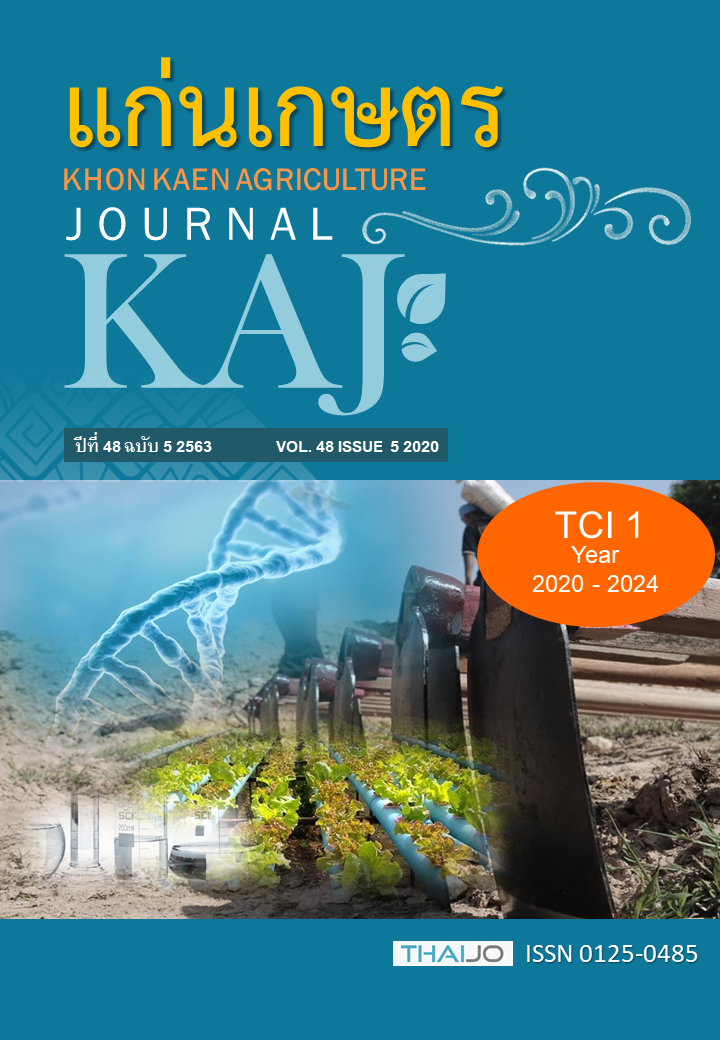การจำแนกสายพันธุ์อ้อยด้วยการตรวจวัดลำอ้อยโดยใช้เครื่องอินฟาเรดย่านใกล้สเปกโทรมิเตอร์แบบพกพา
Main Article Content
บทคัดย่อ
งานวิจัยนี้มีวัตถุประสงค์เพื่อศึกษาและทดสอบความเป็นไปได้ที่จะประยุกต์ใช้เครื่องอินฟาเรดย่านใกล้สเปกโทรมิเตอร์ (Near infrared spectrometer; NIRs) แบบพกพา สำหรับนำมาจำแนกกลุ่มพันธุ์อ้อยที่นิยมปลูกในประเทศไทยระหว่างอ้อยพันธุ์ขอนแก่น 3 (KK3) และ สุพรรณบุรี 50 (SP50) โดยอาศัยหลักการเคโมเมทริกซ์ (Chemometrics) ด้วยวิธีการวิเคราะห์จำแนกกลุ่มด้วยการถดถอยกำลังสองน้อยที่สุด (Partial least square-discriminant analysis, PLS-DA) ซึ่งมีเก็บข้อมูลสเปกตรัมอินฟาเรดย่านใกล้ของตัวอย่างอ้อยในช่วงความยาวคลื่นช่วง 634 - 1124 นาโนเมตรผ่านการสแกนบนลำอ้อยโดยตรงโดยใช้เครื่อง NIRs แบบพกพา ผลการทดสอบพบว่าแบบจำลอง PLS-DA สามารถจำแนกคัดแยกกลุ่มของอ้อยทั้ง 2 สายพันธุ์ได้ โดยมีค่าความถูกต้องของการจำแนกกลุ่ม (Correctly classified) เท่ากับ 100% โดยที่ในขั้นตอนของการสร้างและการทวนสอบความถูกต้องของการจำลองนี้มีการจัดกลุ่มของตัวแปรเดิมเป็นตัวแปรใหม่ได้ 14 แฟกเตอร์ โดยให้ค่าสัมประสิทธิ์การพิจารณาของการจำลอง (Coefficient of determination of calibration, RC2) ค่าเฉลี่ยกำลังสองของความผิดพลาดมาตรฐานของการจำลอง (Root mean square of standard error of calibration, RMSEC) ค่าสัมประสิทธิ์การพิจารณาของการทวนสอบ (Coefficient of determination of validation, RV2) และค่าเฉลี่ยกำลังสองของความผิดพลาดมาตรฐานของการทวนสอบ (Root mean square of standard error of cross-validation, RMSECV) เท่ากับ 0.99, 0.05, 0.98 และ 0.07 ตามลำดับ ซึ่งการศึกษาดังกล่าวเป็นการพิสูจน์เทคโนโลยี NIR ถึงความเป็นไปได้ที่จะนำไปใช้ประโยชน์ในการจำแนกสายพันธุ์ที่มีความหลายหลากโดยเฉพาะในงานพัฒนาปรับปรุงสายพันธุ์อ้อย
Article Details
เอกสารอ้างอิง
สถาบันค้นคว้าและพัฒนาผลิตผลทางการเกษตรและอุตสาหกรรมเกษตร. 2555. เทคโนโลยีอินฟราเรดย่านใกล้และการประยุกต์ใช้ในอุตสาหกรรม. มหาวิทยาลยัเกษตรศาตร์.
สำนักงานคณะกรรมการอ้อยและน้ำตาลทราย. 2560. คนรักษ์อ้อย. แหล่งข้อมูล: http://www.ocsb.go.th/. ค้นเมื่อ 2 มีนาคม 2563.
Cadet, F. and B. Offmann. 1997. Direct spectroscopic sucrose determination of raw sugarcane juices. Journal of Agricultural and Food Chemistry. 45: 166-171.
Fu, X., Y. Zhou, Y. Ying, H. Lu, and H. Xu. 2007. Discrimination of pear varieties using three classification methods based on near-infrared spectroscopy. Transactions of the ASABE. 50: 1355-1361.
Nawi, N. M., T. Jensen, and G. Chen. 2012. The application of spectroscopic methods to predict sugarcane quality based on stalk cross-sectional scanning. Journal of American Society of Sugar Cane Technologists. 32: 16-27
Nawi, N. M., T. Jensen, and G. Chen. 2014a. In-field measurement and sampling technologies for monitoring quality in the sugarcane industry: a review. Precision agriculture. 15: 684-703.
Nawi, N. M., T. Jensen, G. Chen, and C. Baillie. 2012. July. Prediction of sugar content along the height of sugarcane internodes using VisNIR. In Proceedings of the 2012 International Conference of Agricultural Engineering (CIGR-AgEng 2012). International Commission of Agricultural Engineering (CIGR).
Nawi, N. M., T. Jensen, G. Chen, and S. A. Mehdizadeh. 2013. Prediction and classification of sugar content of sugarcane based on skin scanning using visible and shortwave near infrared. Biosystems Engineering. 115: 154-161.
Nawi, N. M., K. M. Rowshon, C. Guangnan, and J. Troy. 2014b. Prediction of sugarcane quality parameters using visible-shortwave near infrared spectroradiometer. Agriculture and Agricultural Science Procedia. 2: 136-143.
Neto, A. J. S., J. V. Toledo, S. Zolnier, D. D. C. Lopes, C. V. Pires and T. G. F. da Silva. 2017. Prediction of mineral contents in sugarcane cultivated under saline conditions based on stalk scanning by Vis/NIR spectral reflectance. Biosystems Engineering. 156: 17-26.
Peternelli, L.A., M. H. P. Barbosa, J. V. Roque, and R. F. Teofilo. 2019. June. Phenotypic classification of sugarcane from near infrared spectra obtained directly from stalk using ordered predictors selection and partial least squares-discriminant analysis. In Proceedings of the 18th International Conference on Near Infrared Spectroscopy. IM Publications Open.
Rambla, F.J., S. Garrigues, and M. De La Guardia. 1997. PLS-NIR determination of total sugar, glucose, fructose and sucrose in aqueous solutions of fruit juices. Analytica Chimica Acta. 344: 41-53.
Sabatier, D., L. Thuriès, D. Bastianelli, and P. Dardenne. 2012. Rapid prediction of the lignocellulosic compounds of sugarcane biomass by near infrared reflectance spectroscopy: comparing classical and independent cross-validation. Journal of Near Infrared Spectroscopy. 20: 371-385.
Taira, E., M. Ueno, S. Takashi, K. Kikuchi, and Y. Kawamitsu. 2015. Non-destructive quality measurement system for cane stalks using a portable NIR instrument. International Sugar Journal. 117: 430-433.
Tamburini, E., G. Ferrari, M. Marchetti, P. Pedrini, and S. Ferro. 2015. Development of FT-NIR models for the simultaneous estimation of chlorophyll and nitrogen content in fresh apple (Malus domestica) leaves. Sensors. 15: 2662-2679.
Tewari, J. C., and K. Malik. 2007. In situ laboratory analysis of sucrose in sugarcane bagasse using attenuated total reflectance spectroscopy and chemometrics. International Journal of Food Science and Technology. 42: 200-207.
Wagih, M. E., A. Ala, and Y. Musa. 2004. Evaluation of sugarcane varieties for maturity earliness and selection for efficient sugar accumulation. Sugar Tech. 6: 297-304.


